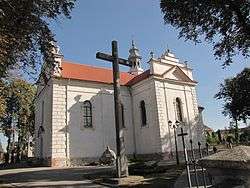Kąkolewnica
Kąkolewnica [kɔnkɔlɛvˈnit͡sa] is a village in Radzyń Podlaski County, Lublin Voivodeship, in eastern Poland. It is the seat of the gmina (administrative district) called Gmina Kąkolewnica.[1] It lies approximately 18 kilometres (11 mi) north of Radzyń Podlaski and 77 km (48 mi) north of the regional capital Lublin.
Kąkolewnica | |
|---|---|
Village | |
 | |
 Kąkolewnica | |
| Coordinates: 51°56′N 22°43′E | |
| Country | |
| Voivodeship | Lublin |
| County | Radzyń Podlaski |
| Gmina | Kąkolewnica Wschodnia |
| Population | 680 |
Kąkolewnica became a unified village on 1 January 2011, formed from the formerly separate villages of Kąkolewnica Północna, Kąkolewnica Południowa, Kąkolewnica Wschodnia (north, south and east Kąkolewnica) and Rudnik.
World War II history
Kąkolewnica was the location of the communist killing fields at Uroczysko Baran – known in Poland as the "Little Katyn" – perpetrated during the advancement of the Red Army across the Polish territories in 1944–1945.[2]
See also
References
- "Central Statistical Office (GUS) - TERYT (National Register of Territorial Land Apportionment Journal)" (in Polish). 2008-06-01.
- Anna Wasak, Doomed Soldiers (2009), Kakolewnica, "Little Katyn" near Radzyn Podlaski: Unsolved Communist Crimes In Poland [Kąkolewnica, podlaski Katyń] (in English and Polish), DoomedSoldiers.com, source: Nasz Dziennik, It is estimated that between 1944 and 1945, some 1,300 to 1,800 Polish underground soldiers from the Home Army, NSZ, WiN and other patriotic organizations were murdered in the Kakolewnica forest known as Uroczysko Baran. The perpetrators were never brought to justice.